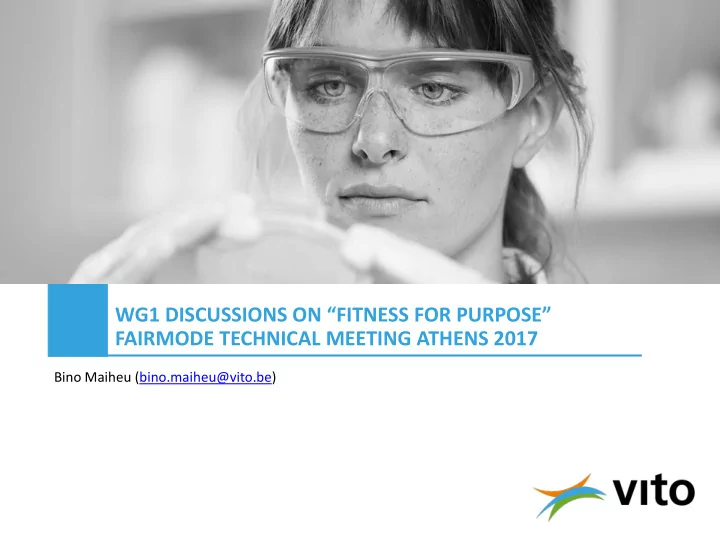

WG1 DISCUSSIONS ON “FITNESS FOR PURPOSE” FAIRMODE TECHNICAL MEETING ATHENS 2017 Bino Maiheu (bino.maiheu@vito.be)
QUESTION 1
QUESTION 1 Do you see (other) elements that define the extent of a model’s fitness -for-purpose with regard to exposure assessment ? Yes, Some food for thought : Exposure is not the same purpose as exceedance assessment Model type vs. application 3 FAIRMODE Technical Meeting – Athens 2017
QUESTION 1 ATMOSYS AQ assessment for Flanders, including street canyon parametrisation (OSPM) 4 FAIRMODE Technical Meeting – Athens 2017
QUESTION 1 Resolution degradation 5 Voettekst invulling
QUESTION 1 Importance of spatial scale Spatial scale degrading (simple averaging) 10 m 20 km shows dramatic decrease in area in exceedance Importance of steet canyon effects increases with spatial scale 6 Voettekst invulling
QUESTION 1 Issue of spatial scale Fitness for purpose for exposure modelling Health impacts : RR CRF NO 2 Population Health Assessment exposure Impacts How CRF’s are derived Epidemiological studies (cohort studies) Beelen et al, 2013 Spatial metrics as surrogates for personal exposure Often using LUR Spatial scale compatibility required , otherwise Biases in health impacts… Meta analyses Spatial scale ? Chicken or the egg : dynamic vs. static exposure Dialog with epi-community required, FAIRMODE cannot tackle this alone… 7 Voettekst invulling
Population weighted concentrations … Source : VITO, under EC DG-ENV Service Contract 070201/2015/SER/717473/C.3 8 Voettekst invulling
Population weighted concentraions … Source : VITO, under EC DG-ENV Service Contract 070201/2015/SER/717473/C.3 9 Voettekst invulling
QUESTION 1 What is model resolution ? AQ model scale is not necessarily the same as spatial resolution E.g. level of detail of available traffic data or urban detail ! All points OSPM Other locations locations Number 1891 647 1181 BIAS -11% -4% -13% RMSE 18% 16% 17% Fit y = 0.63*x + y = 0.49*x + y = 0.55*x + 9.63 18.71 10.74 Region Antwerpen: ~ 50% roads is missing w.r.t. AGIV / OSM 10 FAIRMODE Technical Meeting – Athens 2017
QUESTION 1 Fitness for purpose : model type, criterion matrix ? Different model applications : assessment vs. scenario calculation Criteria : Spatial scale Spatial coverage Temporal scale Data availability … vs Different model types : e.g. LUR vs. dispersion modelling Deal with sensitivities w.r.t. model type dialog E.g. Can LUR’s be applied for scenario assessments Applicability of street box models for complex situations 11 Voettekst invulling
QUESTION 2
QUESTION 2 Do you agree that assessment/definition of the typical spatial variability is one of the main missing criteria to define fitness-for-purpose within the present FAIRMODE concepts? Yes ! However: Should not overlook temporal variability ! Can we use annual averaged models to say something about PM 10 daily limit, NO 2 hourly limit ? Relationship between PM 10 annual average & # days PM 10 > 50 µg/m 3 (e.g. RLB Flanders : 31.3 PM 10 annual avg = 35 days (Celis et al, 2013) Less obvious for NO 2 hourly limit… (# hours NO 2 > 200 µg/m 3 ) Sometimes fitness for purpose has to be argmented in policy context (IEA regulations) 13 Voettekst invulling
QUESTION 2 Example from practise… Complex relation between annual NO 2 & # exceedances Annual averaged model not generally suitable to test NO 2 hourly norm # exceedances Annual avg NO 2 14 Voettekst invulling
QUESTION 2 Health effects Also some health effects are related to short term exposure, though less important than links with long term exposure (annual averaged NO 2 ) H. Walton, KCL 15 Voettekst invulling
QUESTION 3
QUESTION 3 Do you have any preferences or suggestions on how to define the typical spatial variability for the yearly average environmental criteria for NO 2 and PM 2.5 (first focus)? Obvious link to spatial representativeness Look at highest resolution data Learn from extensive measurement campaigns Sensor networks Perhaps also CFD dispersion models Spatial metrics to define spatial structure ? Radius of variance ? Semi-variogram ? … 17 Voettekst invulling
QUESTION 4 Need for spatial metric Radius around given point where standarddeviation stays < 1 µg/m3. NO 2 , vs PM 2.5 18 Voettekst invulling
QUESTION 4 Spatial metric Study semi-variograms for concentration maps ? 𝑂(ℎ) 1 2 𝛿 ℎ = 2𝑂(ℎ) 𝑎 𝑦 𝑗 + ℎ − 𝑎 𝑦 𝑗 𝑗=1 https://en.wikipedia.org/wiki/Variogram 19 Voettekst invulling
QUESTION 4 Need for spatial metric 20 Voettekst invulling
QUESTION 4 Need for spatial metric Semi-variogram as measure for the spatial structure ? Need high density datasets Can model reproduce the experimental semi-variogram ? Curieuzeneuzen … 21 Voettekst invulling
QUESTION 4 Need for spatial metric NO 2 average may 2016 Passive samplers (Palmes tubes) 2000 volunteers 22 Voettekst invulling
QUESTION 4 Need for spatial metric Semi variogram for very detailed measurement campaign Curieuzeneuzen 23 Voettekst invulling
QUESTION 4 Need for spatial metric Is semi-variogram the best metric ? Directionality… Some kind of 2D spatial Fourier or wavelet analysis ? Compare spectra of spatial “frequencies” ? … 24 Voettekst invulling
QUESTION 4
QUESTION 4 Can you come up with proposal for the required spatial resolution for annual averaged NO 2 and PM 2.5 simulations? What kind of information do you base your proposal on? This again depends on the purpose (Question 1) Exceedance modelling : street canyon level Exposure modelling for health impacts Static & current CRF : urban background with road contribution prob. enough : compatibility with CRF Dynamic exposure : street canyon level PM 2.5 much more regionally driven 26 Voettekst invulling
Recommend
More recommend